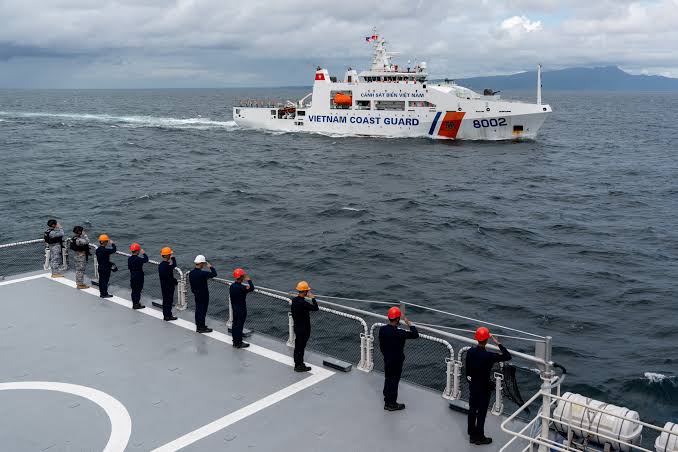First Joint Naval Drills involving Vietnam and Philippines

The coast guards of the Philippines and Vietnamese conducted their first joint drills in firefighting, rescue, and medical response in Manila Bay, off the west coast of Luzon, the Philippines’ main island, leading into the West Philippines Sea. This is the first such drills amid escalating tensions in the West Philippines Sea / Natuna Sea.
The exercise on Friday is the first such joint activity between the coast guards of the two countries amid ongoing territorial disputes with each other and, more significantly, with China, which claims almost the entire Sea as its own.
The drills featured a simulated search and rescue operation and the use of water cannons to repel a mock threat.
Jay L Batongbacal, a professor at the University of the Philippines College of Law, said the strengthened relations and security cooperation between Vietnam and the Philippines serve as a significant counter to Beijing’s increasingly expansionist and assertive actions in the West Philippines Sea/ Natuna Sea.
“Since both [countries] carry these activities out fully under international law, it should be seen as a stabilising factor and deterrent to Chinese aggression, and at the same time stand for asserting and maintaining international law,” Batongbacal said.
Although the Philippines and Vietnam face overlapping sovereignty disputes with China in the West Philippines Sea/ Natuna Sea, Batongbacal views this first-ever Philippines-Vietnam exercise as a key demonstration of how claimant countries should interact.
“It is a demonstration of what is possible between claimants who are sincere in their declarations to cooperate and improve relations, temporarily setting aside the disputes and maintaining the status quo,” Batongbacal said.
“So even if they do not have active and direct cooperation, their activities contribute to maintaining the regional balance of power because of their common goals and converging interests,” he added.
Vietnam said in late June that it was open to discussing overlapping claims with the Philippines in the West Philipines Sea / Natuna Sea.
Since Ferdinand Marcos Jr took office in 2022, the Philippine government has adopted a more assertive stance on the West Philippines Sea, differing from his predecessor, Rodrigo Duterte. This shift has heightened maritime tensions with China as Beijing has sought to assert its claims to the region.
In mid-June 2024, the Philippines accused Chinese coast guards of boarding a Philippine navy vessel near Second Thomas Shoal, confiscating equipment, and causing a severe injury to a Philippine sailor.
Just ahead of the joint exercise with Vietnam, the Philippines conducted multilateral maritime exercises with the US, Australia, and Canada on August 7-8.
According to a joint statement, the exercises aimed at “safeguarding the right to freedom of navigation and overflight in the West Philippines Sea / Natuna Sea “.
Additionally, the Philippines and Japan held their first joint exercises in the South China Sea on August 2, despite Beijing’s repeated warnings to “extraterritorial states” against interfering in the region.
Notably, China’s Foreign Ministry has not yet commented on the Philippines-Vietnam joint drills but Beijing’s spokesperson, Mao Ning repeated Beijing’s claim, “It is the Philippines, not China, that is creating problems in the West Philippines Sea.”
The Chinese People’s Liberation Army (PLA) announced on August 7 that its Southern Theater Command had conducted air and sea combat patrols near Scarborough Shoal– an area with a long-standing sovereignty dispute between China and the Philippines.
Ding Duo, deputy director of the Institute of Marine Law and Policy at the China Institute of South China Sea Studies, said that Beijing is likely to respond with measured concern to the Vietnam-Philippines joint exercise despite the ongoing disputes over territorial sovereignty and maritime boundaries.
“The venue for the Vietnam-Philippines joint exercise is Manila Bay, and the scale of the exercise is relatively small,” Ding said. “Its defensive nature suggests that China will probably view it as a routine instance of bilateral security and military cooperation among regional nations.”
Ding said China aims to prevent Vietnam-Philippines cooperation from growing into a broader alliance that could challenge its interests.
“I believe China may use diplomatic or party-to-party channels to address military security concerns and mitigate the risk of potential miscalculations,” Ding said.
Beijing has been stepping up its friendly military engagements and exercises with Hanoi, as the two sides have sought to reduce historic tensions in the West Philippines Sea / Natuna Sea.
China’s state-run Xinhua news agency reported that on August 7, the Vietnam people’s navy’s guided-missile frigate 015 Tran Hung Dao arrived at Zhanjiang, a naval port in southeast Guangdong province for a visit.
The PLA stated that the visit would include “ship tours, deck receptions, cultural exchanges, joint exercises, and other activities” aimed at “improving mutual understanding and trust between the Chinese and Vietnamese navies and further strengthening the friendship between the two naval forces.”
In June, four ships from the Chinese and Vietnamese navies held a two-day joint patrol exercise in the Gulf of Tonkin between Vietnam and China, which Chinese state media said was their 36th such drill.
Meanwhile, China and the Philippines have tried to improve their relations since the June clash. Chinese and Filipino officials, in a July 2 meeting in Manila, agreed to reduce tensions and even consider cooperation between their coast guards.
VOA reported, citing analysts, that this first joint exercise between Hanoi and Manila is likely to carry significance beyond its immediate scope.
Nguyen Khac Giang is a visiting scholar at the Vietnam Studies Program at the ISEAS-Yusof Ishak Institute.
“I think that is important because although this is only a search and rescue exercise and not a military drill, I think it will signal further collaboration between the two countries in the future, including military exercises and other activities in the region. So I think it’s very important for both countries going forward,” Nguyen told VOA.
Nguyen highlighted that Vietnam and Indonesia successfully concluded negotiations on their exclusive economic zone (EEZ) in the Natuna Sea at the end of 2022.
He suggested that if Vietnam and the Philippines can use this joint exercise to address their overlapping border issues, it could represent the potential for Association of Southeast Asian Nation (ASEAN) claimants in the West Philippines Sea / Natuna Sea to enhance cooperation and collectively address challenges posed by China.
“Because China always wants to divide and conquer, they want to negotiate with each country individually because it will give them better leverage,” Nguyen said.
However, Nguyen noted that if ASEAN countries like Vietnam and the Philippines can work together, it would strengthen their ability to counter Chinese influence not only in terms of military presence in the West Philippines Sea / Natuna Se but also on diplomatic and economic fronts, as reported by VOA.




